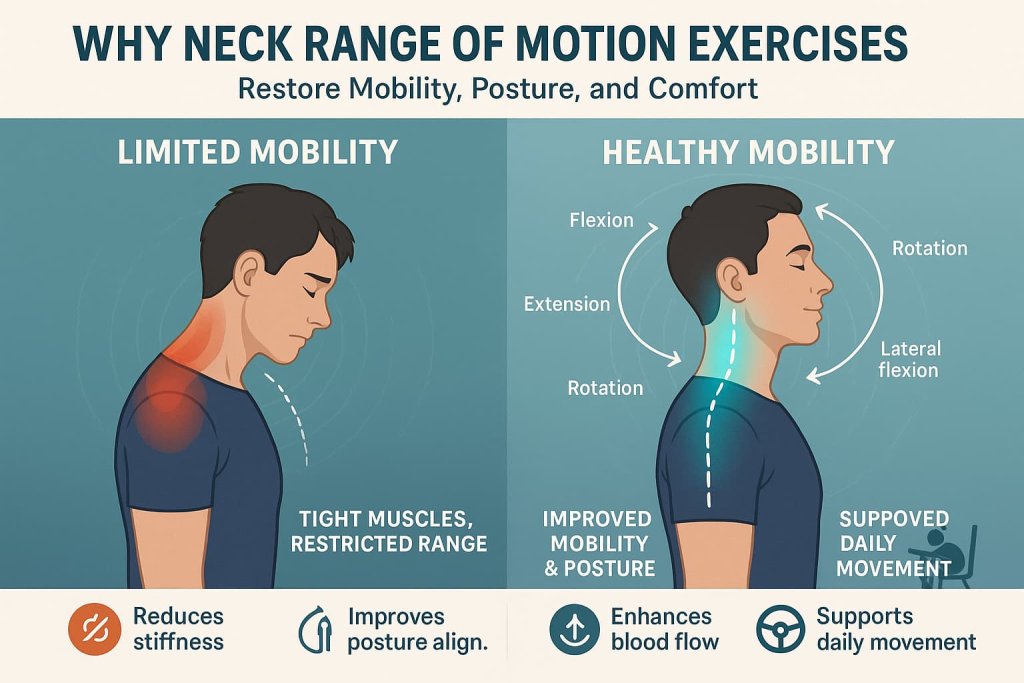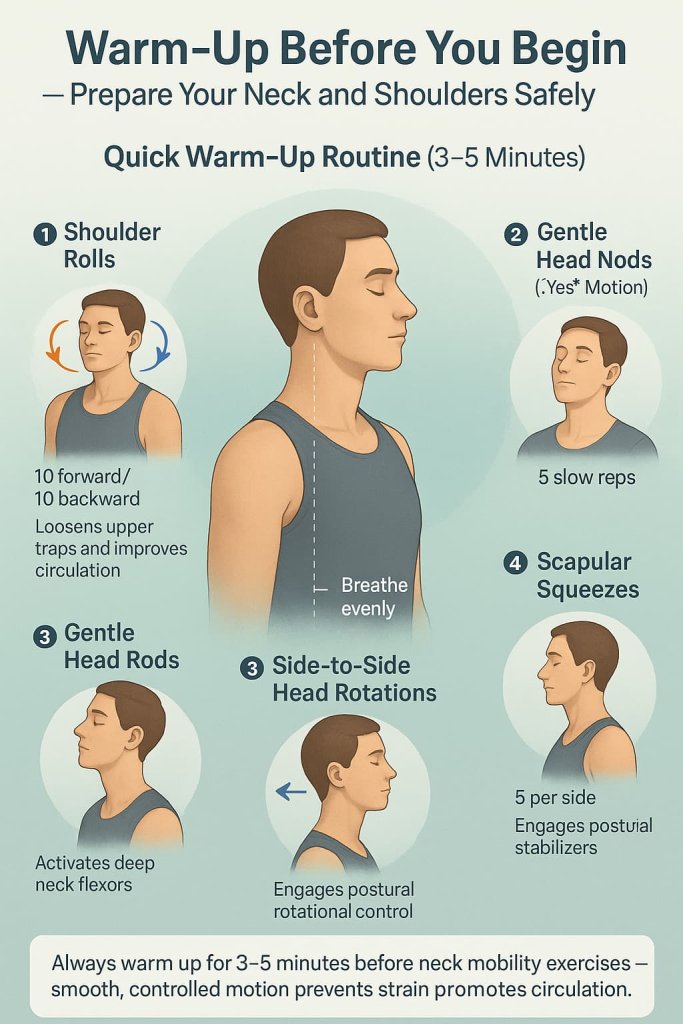Yes — neck range of motion exercises can relieve stiffness, improve posture, and restore mobility effectively when done consistently and safely. These movements are simple yet essential for keeping your neck flexible, strong, and pain-free.
Understanding neck mobility is important because the cervical spine supports the weight of your head (around 10–12 lbs) and allows movement in multiple planes. Over time, poor posture, desk work, or prolonged phone use can limit this motion, leading to tightness or headaches.

This guide walks you through 10 best neck range-of-motion (ROM) exercises—clinically backed, easy to follow, and safe for beginners or office workers alike.
Why Neck Range of Motion Exercises Matter
Neck ROM exercises help your neck move through its natural arcs—flexion, extension, rotation, and lateral flexion. Studies published in The Journal of Orthopaedic & Sports Physical Therapy (2017) confirm that regular mobility work improves joint mechanics, reduces pain, and supports posture when paired with upper-back strengthening.

Common benefits include:
- Reducing stiffness and muscular tension
- Improving posture and spinal alignment
- Enhancing blood flow to neck and shoulder muscles
- Supporting daily activities like driving or reading
- Preventing neck pain from poor ergonomics
Typical healthy neck ROM values are approximately 50–60° flexion, 70–80° rotation, 35–45° lateral flexion, and 60–75° extension—targets you can gradually approach with these exercises.
Warm-Up Before You Begin
Always begin with 3–5 minutes of light movement to loosen muscles and prepare joints.

Quick Warm-Up Routine:
- Shoulder rolls – 10 forward/back
- Gentle head nods – 5 slow reps
- Side-to-side head rotations – 5 per side
- Scapular squeezes – 10 reps
Trainer Tip: Move slowly, breathe evenly, and avoid sharp pain or dizziness.
10 Best Neck Range of Motion Exercises
These 10 neck range of motion exercises are designed to restore flexibility, improve posture, and reduce everyday stiffness caused by poor ergonomics or prolonged sitting. Perform them slowly and consistently to enhance mobility, support joint health, and maintain pain-free neck movement.
1. Chin Tuck (Cervical Retraction)
Why it works:
Corrects forward-head posture and strengthens the deep cervical flexors that stabilize your neck. This exercise helps realign the head over the shoulders, easing strain on the upper traps and suboccipitals.
Muscles worked:
Deep cervical flexors (longus colli, longus capitis), suboccipitals, sternocleidomastoid (stabilizing role).
How to do it:
- Sit or stand tall with shoulders relaxed.
- Gently draw your chin straight backward as if creating a “double chin.”
- Keep your gaze level and avoid nodding.
- Hold for 3 seconds, then relax.
- Repeat for 10 slow, controlled repetitions.
Trainer Tip:
Imagine your head sliding straight back along a wall—avoid tipping it up or down.
2. Neck Flexion & Extension
Why it works:
Improves sagittal-plane motion essential for daily head movements like looking up, reading, or checking your phone safely. It maintains flexibility of anterior and posterior neck structures.
Muscles worked:
Flexion – sternocleidomastoid, longus colli, scalene group.
Extension – splenius capitis, semispinalis capitis, upper trapezius.
How to do it:
- Sit upright with relaxed shoulders.
- Lower your chin gently toward your chest; hold for 3 seconds.
- Return to neutral, then slowly look upward to your comfortable limit; hold 3 seconds.
- Perform 8–10 controlled repetitions.
Trainer Tip:
If you feel dizziness or joint compression when looking up, shorten your range or pause between reps.
3. Neck Rotation
Why it works:
Enhances ability to look over your shoulders and balances motion between left and right sides, reducing stiffness from prolonged desk work.
Muscles worked:
Sternocleidomastoid, splenius capitis, levator scapulae, scalenes.
How to do it:
- From a neutral position, slowly turn your head to the right until you reach gentle tension.
- Hold 2–3 seconds, return to center, then rotate to the left.
- Complete 8–10 reps per side.
Trainer Tip:
Keep shoulders square and relaxed; only the neck should move.
4. Lateral Flexion (Ear to Shoulder)
Why it works:
Stretches tight upper-trap and scalene muscles that often cause neck and shoulder tension. It also maintains side-to-side mobility and symmetry.
Muscles worked:
Upper trapezius, levator scapulae, scalenes, sternocleidomastoid.
How to do it:
- Sit tall and tilt your right ear toward your right shoulder.
- Keep shoulders level—don’t lift them.
- Hold 3 seconds, return to center.
- Repeat to the left for 8–10 reps per side.
Trainer Tip:
Visualize your head as floating—avoid forcing or pulling it down with your hand.
5. Chin Tuck with Extension
Why it works:
Combines posture correction with gentle posterior-chain mobility. It strengthens deep neck flexors while improving upper-cervical extension—a critical movement for balanced posture.
Muscles worked:
Deep cervical flexors, semispinalis capitis, splenius cervicis, suboccipitals.
How to do it:
- Start with a chin tuck (head slides straight back).
- While maintaining the tuck, slowly look slightly upward.
- Hold 2–3 seconds, then return to neutral.
- Perform 6–8 reps.
Trainer Tip:
If you feel pinching in the back of the neck, reduce the range or slow down the motion.
6. Controlled Half-Neck Rolls
Why it works:
Mobilizes multiple planes of motion in one smooth pattern. It loosens fascial tension and improves coordination of cervical joints.
Muscles worked:
Combined action of upper trapezius, scalenes, sternocleidomastoid, splenius group.
How to do it:
- Drop your chin gently toward your chest.
- Roll your head slowly toward your right shoulder, then back to center, then to the left shoulder.
- Perform 4–6 smooth half-circles.
Trainer Tip:
Avoid full circular rolls—they can stress cervical joints and arteries.
7. Isometric Neck Extension
Why it works:
Builds endurance and stability in the neck extensors, supporting the head’s weight without excessive strain. Excellent for improving posture control in sedentary individuals.
Muscles worked:
Splenius capitis, semispinalis capitis, trapezius (upper fibers), suboccipitals.
How to do it:
- Place both hands behind your head.
- Gently press your head backward into your hands without actual movement.
- Hold for 5 seconds, relax, repeat 5–8 times.
Trainer Tip:
Apply light, even pressure—resistance should feel activating, not fatiguing.
8. Side Glides (Lateral Translation)
Why it works:
Improves segmental mobility of cervical joints, particularly for those with stiffness from desk posture or unilateral tension.
Muscles worked:
Scalenes, deep cervical stabilizers, levator scapulae (stabilizing role).

How to do it:
- Sit tall and move your head straight to the right—imagine sliding it sideways without tilting.
- Hold 2 seconds, return to center, then repeat to the left.
- Perform 8–10 reps per side.
Trainer Tip:
Think of your head gliding between two walls—keep your chin level and avoid shoulder movement.
9. Shoulder Blade Retraction with Chin Tuck
Why it works:
Links cervical and thoracic posture, strengthening both the neck and scapular stabilizers for long-term alignment.
Muscles worked:
Rhomboids, middle and lower trapezius, deep neck flexors.
How to do it:
- Sit or stand upright.
- Draw shoulder blades down and together.
- At the same time, perform a chin tuck.
- Hold 3 seconds, relax, repeat 8–10 times.
Trainer Tip:
Avoid shrugging—think “down and back.” Move smoothly and breathe throughout.
10. Assisted Neck Flexion/Extension
Why it works:
Adds tactile feedback for improved awareness and control, gently strengthening neck flexors and extensors through light resistance.
Muscles worked:
Flexion – sternocleidomastoid, deep neck flexors.
Extension – splenius and semispinalis capitis, upper trapezius.
How to do it:
- Flexion: Place your palm on your forehead. Press lightly while nodding chin toward chest.
- Extension: Place your hand behind your head. Press gently backward as you look up slightly.
- Hold each position for 3 seconds.
- Repeat 5–6 times per direction.
Trainer Tip:
Use only 10–20 % effort—just enough to feel engagement. Never push into pain or strain.
Safety Tips & Contraindications
- Avoid exercises if you have acute injury, cervical instability, or radiating arm pain unless cleared by a clinician.
- Move within a comfortable, pain-free range only.
- Stop if you experience dizziness, tingling, or numbness.
- Maintain neutral posture and controlled breathing.
Programming Guidelines
| Goal | Frequency | Duration | Notes |
|---|---|---|---|
| Maintain flexibility | 1–2× daily | 5–10 min | Ideal for desk workers |
| Restore mobility (after stiffness) | 2–3× daily | 10–15 min | Include warm-up |
| Prevent posture fatigue | 3× week | 10 min | Combine with scapular work |
Progression:
Start with smaller movements, increase range and hold time gradually over 2–4 weeks. Once motion improves, integrate gentle strengthening (e.g., wall nods, scapular holds).
Common Mistakes
- Moving too quickly — increases risk of strain.
- Lifting shoulders during stretches — reduces effect.
- Holding breath — raises tension.
- Ignoring posture — limits long-term benefits.
FAQs
1. How often should I do neck ROM exercises?
Once or twice daily is safe for most people. Morning and post-work sessions work best.
2. Should I stretch before or after strength training?
ROM work is ideal as part of warm-up or cooldown—it restores alignment and mobility.
3. Can these exercises help neck pain?
They may reduce discomfort caused by stiffness or posture, but seek professional advice for persistent or severe pain.
4. Is it normal to feel a gentle stretch?
Yes, a light pulling sensation is fine—avoid sharp pain or tingling.
5. Do I need equipment?
No equipment is required—just good posture and controlled movement.
6. Can seniors do these exercises?
Yes. They are low-impact and safe if performed slowly within comfortable range.
7. How long until I notice results?
With daily practice, flexibility improvements are often seen within 2–4 weeks.
Conclusion
Daily neck range-of-motion exercises restore flexibility, improve posture, and prevent tension buildup. Just 10 minutes a day can make a measurable difference in comfort and movement quality. Start today—pick 3–5 exercises, perform them gently, and stay consistent.
This content is for informational purposes only and not medical advice.
References
- APTA Orthopaedic Section CPG — Neck Pain: Revision 2017 (JOSPT)
https://www.jospt.org/doi/10.2519/jospt.2017.0302 - Clinical Practice Guideline for Nonspecific Neck Pain (Phys Ther, 2018)
https://pubmed.ncbi.nlm.nih.gov/29228289/ - NHS — Neck pain and a stiff neck (self-care & exercises)
https://www.nhs.uk/conditions/neck-pain-and-stiff-neck/ - Cochrane Review — Exercises for Mechanical Neck Disorders (2012)
https://www.cochranelibrary.com/cdsr/doi/10.1002/14651858.CD004250.pub4/full - OPTIMa Guideline — Management of Neck Pain & Associated Disorders (Eur Spine J, 2016)
https://link.springer.com/article/10.1007/s00586-016-4467-7 - Normative Cervical ROM — Youdas et al., Phys Ther (1992)
https://pubmed.ncbi.nlm.nih.gov/1409872/ - Bridgewater NHS FT — Neck Range of Motion Exercises (Patient Advice Sheet)
https://bridgewater.nhs.uk/wp-content/uploads/2020/12/Neck-range-of-motion-exercises-Patient-advice-sheet.pdf
